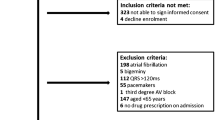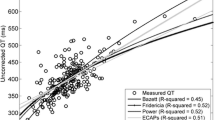Abstract
Aims
The objective of this study was to evaluate the prevalence of the prescription of QT-prolonging drugs at hospital admission and discharge and the risk factors associated with their use in older people (aged 65 years and older).
Methods
Data were obtained from the REPOSI (REgistro POliterapie SIMI [Società Italiana di Medicina Interna]) registry, which enrolled 4035 patients in 2008 (n = 1332), 2010 (n = 1380), and 2012 (n = 1323). Multivariable logistic regression was performed to determine the risk factors independently associated with QT-prolonging drug use. QT-prolonging drugs were classified by the risk of Torsades de Pointes (TdP) (definite, possible, or conditional) according to the Arizona Center for Education and Research on Therapeutics (AzCERT) classification. Specific drug combinations were also assessed.
Results
Among 3906 patients prescribed at least one drug at admission, 2156 (55.2 %) were taking at least one QT-prolonging drug. Risk factors independently associated with the use of any QT-prolonging drugs were increasing age (odds ratio [OR] 1.02, 95 % CI 1.01–1.03), multimorbidity (OR 2.69, 95 % CI 2.33–3.10), hypokalemia (OR 2.79, 95 % CI 1.32–5.89), atrial fibrillation (OR 1.66, 95 % CI 1.40–1.98), and heart failure (OR 3.17, 95 % CI 2.49–4.05). Furosemide, alone or in combination, was the most prescribed drug. Amiodarone was the most prescribed drug with a definite risk of TdP. Both the absolute number of QT-prolonging drugs (2890 vs. 3549) and the number of patients treated with them (2456 vs. 2156) increased at discharge. Among 1808 patients not prescribed QT-prolonging drugs at admission, 35.8 % were prescribed them at discharge.
Conclusions
Despite their risk, QT-prolonging drugs are widely prescribed to hospitalized older persons. The curriculum for both practicing physicians and medical students should be strengthened to provide more education on the appropriate use of drugs in order to improve the management of hospitalized older people.
Similar content being viewed by others
References
Yap YG, Camm AJ. Drug induced QT prolongation and torsades de pointes. Heart. 2003;89(11):1363–72.
CredibleMeds®. https://www.crediblemeds.org. Accessed 30 Jan 2015.
Zhang Y, Post WS, Blasco-Colmenares E, Dalal D, Tomaselli GF, Guallar E. Electrocardiographic QT interval and mortality: a meta-analysis. Epidemiology. 2011;22(5):660–70.
Montanez A, Ruskin JN, Hebert PR, Lamas GA, Hennekens CH. Prolonged QTc interval and risks of total and cardiovascular mortality and sudden death in the general population: a review and qualitative overview of the prospective cohort studies. Arch Intern Med. 2004;164(9):943–8.
European Medicines Agency (EMA). Domperidone-containing medicines. http://www.ema.europa.eu/ema/index.jsp?curl=pages/medicines/human/referrals/Domperidone-containing_medicines/human_referral_prac_000021.jsp&mid=WC0b01ac05805c516f. Accessed 30 Jan 2015.
Bardai A, Amin AS, Blom MT, Bezzina CR, Berdowski J, Langendijk PN, et al. Sudden cardiac arrest associated with use of a non-cardiac drug that reduces cardiac excitability: evidence from bench, bedside, and community. Eur Heart J. 2013;34(20):1506–16.
Straus SM, Bleumink GS, Dieleman JP, van der Lei J, ‘t Jong GW, Kingma JH, et al. Antipsychotics and the risk of sudden cardiac death. Arch Intern Med. 2004;164(12):1293–7.
Ray WA, Murray KT, Hall K, Arbogast PG, Stein CM. Azithromycin and the risk of cardiovascular death. N Engl J Med. 2012;366(20):1881–90.
Kazmierczak J, Peregud-Pogorzelska M, Rzeuski R. QT interval prolongation and torsades de pointes due to a coadministration of ciprofloxacin and azimilide in a patient with implantable cardioverter-defibrillator. Pacing Clin Electrophysiol. 2007;30(8):1043–6.
Keivanidou A, Arnaoutoglou C, Krommydas A, Papanikolaou G, Tsiptses K, Chrisopoulos C, et al. Ciprofloxacin induced acquired long QT syndrome in a patient under class III antiarrhythmic therapy. Cardiol J. 2009;16(2):172–4.
Letsas KP, Sideris A, Kounas SP, Efremidis M, Korantzopoulos P, Kardaras F. Drug-induced QT interval prolongation after ciprofloxacin administration in a patient receiving olanzapine. Int J Cardiol. 2006;109(2):273–4.
Kounas SP, Letsas KP, Sideris A, Efraimidis M, Kardaras F. QT interval prolongation and torsades de pointes due to a coadministration of metronidazole and amiodarone. Pacing Clin Electrophysiol. 2005;28(5):472–3.
Boyce MJ, Baisley KJ, Warrington SJ. Pharmacokinetic interaction between domperidone and ketoconazole leads to QT prolongation in healthy volunteers: a randomized, placebo-controlled, double-blind, crossover study. Br J Clin Pharmacol. 2012;73(3):411–21.
Burger CI, Clase CM, Gangji AS. Case report: drug interaction between tacrolimus and amiodarone with QT prolongation. Transplantation. 2010;89(9):1166–7.
Charbit B, Alvarez JC, Dasque E, Abe E, Demolis JL, Funck-Brentano C. Droperidol and ondansetron-induced QT interval prolongation: a clinical drug interaction study. Anesthesiology. 2008;109(2):206–12.
Slovacek L, Priester P, Petera J, Slanska I, Kopecky J. Tamoxifen/norfloxacin interaction leading to QT interval prolongation in a female patient with extracranial meningioma. Bratisl Lek Listy. 2011;112(6):353–4.
Thomas AR, Chan LN, Bauman JL, Olopade CO. Prolongation of the QT interval related to cisapride–diltiazem interaction. Pharmacotherapy. 1998;18(2):381–5.
Samarendra P, Kumari S, Evans SJ, Sacchi TJ, Navarro V. QT prolongation associated with azithromycin/amiodarone combination. Pacing Clin Electrophysiol. 2001;24(10):1572–4.
Marengoni A, Angleman S, Melis R, Mangialasche F, Karp A, Garmen A, et al. Aging with multi-morbidity: a systematic review of the literature. Ageing Res Rev. 2011;10:430–9.
Bernabei R, Caputi A, Di Cioccio L, Fini M, Gallo PF, Marchionni N, et al. Need for redesigning pharmacologic research in older individuals. A position statement of the Geriatric Working Group of the Agenzia Italiana del Farmaco (AIFA). J Gerontol A Biol Sci Med Sci. 2011;66:66–7.
Nobili A, Licata G, Salerno F, Pasina L, Tettamanti M, Franchi C, SIMI Investigators, et al. Polypharmacy, length of hospital stay, and in-hospital mortality among elderly patients in internal medicine wards. The REPOSI study. Eur J Clin Pharmacol. 2011;67:507–19.
Pasina L, Djade CD, Nobili A, Tettamanti M, Franchi C, Salerno F, et al. Drug-drug interactions in a cohort of hospitalized elderly patients. Pharmacoepidemiol Drug Saf. 2013;22:1054–60.
Nachimuthu S, Assar MD, Schussler JM. Drug-induced QT interval prolongation: mechanisms and clinical management. Ther Adv Drug Saf. 2012;3(5):241–53.
Mannucci PM, Nobili A, REPOSI Investigators. Multimorbidity and polypharmacy in the elderly: lessons from REPOSI. Intern Emerg Med. 2014;9(7):723–34.
Shah S, Vanclay F, Cooper B. Improving the sensitivity of the Barthel Index for stroke rehabilitation. J Clin Epidemiol. 1989;42:703–9.
Miller MD, Towers A. Manual of guidelines for scoring the Cumulative Illness Rating Scale for Geriatrics (CIRS-G). Pittsburg: University of Pittsburgh; 1991.
Curtis LH, Østbye T, Sendersky V, Hutchison S, Allen LaPointe NM, Al-Khatib SM, et al. Prescription of QT-prolonging drugs in a cohort of about 5 million outpatients. Am J Med. 2003;114(2):135–41.
Onder G, Bonassi S, Abbatecola AM, Folino-Gallo P, Lapi F, Marchionni N, Geriatrics Working Group of the Italian Medicines Agency, et al. High prevalence of poor quality drug prescribing in older individuals: a nationwide report from the Italian Medicines Agency (AIFA). J Gerontol A Biol Sci Med Sci. 2014;69(4):430–7.
Tay KY, Ewald MB, Bourgeois FT. Use of QT-prolonging medications in US emergency departments, 1995–2009. Pharmacoepidemiol Drug Saf. 2014;23(1):9–17.
Pasina L, Nobili A, Tettamanti M, Salerno F, Corrao S, Marengoni A, et al. Prevalence and appropriateness of drug prescriptions for peptic ulcer and gastro-esophageal reflux disease in a cohort of hospitalized elderly. Eur J Intern Med. 2011;22(2):205–10.
Pasquier M, Pantet O, Hugli O, Pruvot E, Buclin T, Waeber G, et al. Prevalence and determinants of QT interval prolongation in medical inpatients. Intern Med J. 2012;42(8):933–40.
Vandael E, Marynissen T, Reyntens J, Spriet I, Vandenberghe J, Willems R, et al. Frequency of use of QT-interval prolonging drugs in psychiatry in Belgium. Int J Clin Pharm. 2014;36(4):757–65.
Author contributions
Study concept and design: Carlotta Franchi, Ilaria Ardoino. Acquisition, analysis, or interpretation of data: Carlotta Franchi, Ilaria Ardoino. Drafting of the manuscript: Carlotta Franchi, Ilaria Ardoino. Critical revision of the manuscript for important intellectual content: all authors. Statistical analysis: Ilaria Ardoino. Study supervision: Carlotta Franchi, Pier Mannuccio Mannucci, Alessandro Nobili.
Author information
Authors and Affiliations
Consortia
Corresponding author
Ethics declarations
Funding
No funding was received for the conduct of this study or preparation of this manuscript.
Conflict of interest
C Franchi, I Ardoino, R Rossio, A Nobili, E M. Biganzoli, A Marengoni, M Marcucci, L Pasina, M Tettamanti, S Corrao, P M Mannucci declare that they have no conflict of interest.
Additional information
C. Franchi and I. Ardoino contributed equally to this work.
REPOSI denotes the REgistro POliterapie SIMI (Società Italiana di Medicina Interna); the full list of contributors is available online as Electronic Supplementary Material.
Electronic supplementary material
Below is the link to the electronic supplementary material.
Rights and permissions
About this article
Cite this article
Franchi, C., Ardoino, I., Rossio, R. et al. Prevalence and Risk Factors Associated with Use of QT-Prolonging Drugs in Hospitalized Older People. Drugs Aging 33, 53–61 (2016). https://doi.org/10.1007/s40266-015-0337-y
Published:
Issue Date:
DOI: https://doi.org/10.1007/s40266-015-0337-y




